October 1959 Popular Electronics
 Table
of Contents Table
of Contents
Wax nostalgic about and learn from the history of early electronics. See articles
from
Popular Electronics,
published October 1954 - April 1985. All copyrights are hereby acknowledged.
|
While acoustical tiles
are not exactly the stuff of RF engineering, their properties and their effects
on sound waves are analogous to RF absorbers and their effects on electromagnetic
waves. Reflections that cause multipath reception of signals that contain the same
information but are out of phase and unequal in amplitude to the primary (direct)
path seldom combine to enhance the overall signal-to-noise ratio, so placing absorbent
material in the surrounding environment is necessary to improve signal quality.
This article from a 1959 issue of Popular Electronics goes through the
process of outfitting an area with acoustical tiles and gives some empirical test
data from before and after.
Acoustical Tile - A New Hi-Fi Component
By Andrew Lorant
You can improve the listening quality of your hi-fi system, especially stereo,
with acoustical tile. How this new component helps make hi-fi sound better, and
how you can install it in your house, will be describes in this, and future articles.
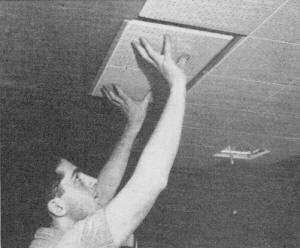
Enjoyment of hi-fi - especially stereo - can usually be improved
by installing acoustical tile in the listening area.
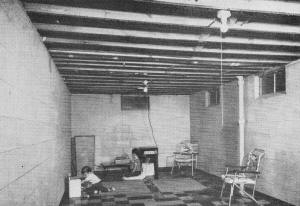
Measurements have been made to determine the practical effects
of installing acoustical tile. Above is the test room before it received acoustical
treatment. The many hard surfaces in this room made the enjoyment of music very
difficult.

Treatment of test room with acoustical tile results in better
room acoustics and better looks, too.

Professional sound-measuring instruments were necessary to obtain
data on the results of installing various amounts of acoustical tile.
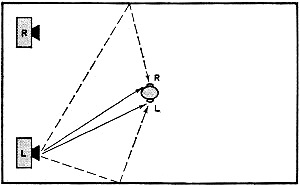
Fig. 1. The solid lines indicate direct sound paths; the
dashed lines show some possible paths for reflected sound.
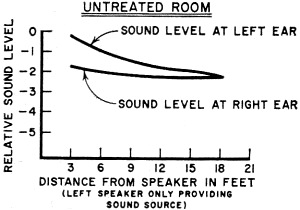
Fig. 2. Untreated room shows negligible differences in sound
levels at left and right "ears" beyond 6 feet from speaker.
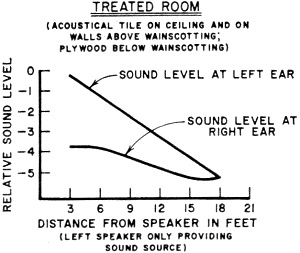
Fig. 3. After treatment with acoustical tile, test room
shows improved stereo separation up to 15 feet from speaker.
The manufacturers of hi-fi equipment have been able to provide many methods of
controlling sound - bass and treble tone controls, filters, loudness compensating
controls, and so on. But all of these exert their effects on the sound before it
is produced. To provide complete control of sound, we need some way of regulating
the sound after it is produced. This we can do only by altering the acoustical properties
of the listening room.
One way to achieve acoustical control is by putting sound-absorbent furnishings
- chairs, rugs, drapes, etc. - in the room. Obviously, this method is limited in
flexibility by practical factors; after all, only just so many overstuffed chairs
can be fitted into any given room.
A simpler method involves the use of acoustical tile. This material is particularly
good because, in addition to its sound-controlling properties, acoustical tile is
easy to install, flexible in installation, and is available in a variety of decorator
patterns. Cost is surprisingly low and the results, from an acoustical standpoint,
are well worth while.
How does a sound-absorbent material like acoustical tile work? Well, imagine
that you are in a room with four hard walls and a volley of ping-pong balls, rather
than sound waves, is being propelled from your speaker system. The ping-pong balls
will bounce merrily back and forth from wall to wall. Now, while the original balls
are still bouncing around, if a second volley of balls were to be "shot" out of
the speaker, all the balls would mix together and it would be impossible to distinguish
one group from the other.
This, in effect, is what happens to sound when it is reflected from hard-surfaced
walls, ceilings and floors. The direct wave of sound from the speakers mixes together
with the reflected sound. By the time the music reaches your ears, it has been so
colored by room acoustics that no amount of knob-twisting can make it sound realistic.
Now consider what happens when sound-absorbent materials are added to the room.
When sound hits them, it stops bouncing around like so many ping-pong balls, But
you can go overboard using these materials; unless you are careful, too much sound
absorption will create a "dull" or "hollow" effect.
It's plain to see, therefore, that acoustical problems cannot be solved by merely
adding sound-absorbent materials indiscriminately. The acoustic surroundings must
be controlled. And this is where acoustical tile comes to the rescue.
By installing acoustical tile on the ceiling and then applying varying amounts
of tile on the walls, any degree of sound absorption can be attained. Because of
its extreme flexibility of installation, acoustical tile offers infinite opportunities
for the design of a listening room which will suit any listening taste.
In addition to its importance as a sound-controlling factor, acoustical tile
is useful in cutting down unwanted sounds. If, for example, you wish to listen to
hi-fi in the basement while the rest of the family is watching TV upstairs, acoustical
tile on the ceiling will help prevent sound transmission from one room to another.
Since the introduction of stereo, the acoustical treatment of the listening room
has become even more important than with monophonic hi-fi systems. Ideally speaking,
each ear should receive sound from only one of the stereo speakers. The left speaker,
for example, should make its strongest impression on the left ear, and sound from
the right speaker should be concentrated on the right ear.
For acoustical treatment in a stereo room, therefore, you may find it advisable
to put acoustical tile part way down the walls along each speaker enclosure. This
will help prevent sounds from the speakers from getting bounced over to the wrong
side of the room.
Obviously, then, the treatment of a room with acoustical tile involves not only
the amount of tile used, but also where it is placed. By carefully studying the
many scholarly books that have been written about acoustics, you can find out how
much sound-absorbent material is optimum for a room with a given volume of air;
but it's more difficult to get some practical guidance that tells where and how
to install it.
Accordingly, a test room has been set up to make the necessary measurements and
evaluations Since measurements under as wide a variation of conditions as possible
were desired, a basement room with concrete walls, rubber tile flooring, and open
beam ceiling was chosen. By erecting "dummy" walls, false ceilings, etc., a number
of different conditions could be simulated without too much difficulty.
The preliminary results of these tests (which are presented in the section below)
indicate that the application of acoustical tile has undoubtedly improved the acoustics
of the test room, but since the study is necessarily detailed, the conclusive report
on the measurements will be presented next month rather than in this issue. In the
meantime, you might start checking into the advisability of installing acoustical
tile in your listening room.
Does Acoustical Tile Really Make a Difference?
What does acoustical tile add to the enjoyment of a stereo system? To find the
answer, a series of tests was undertaken during the installation of acoustical tile
in a typical listening area.
Stereo Acoustics
To obtain the greatest stereo effect, the left ear should receive
the sound from the left speaker, the right ear from the right speaker. This situation,
however, can be only partially realized because each ear also hears the "other"
speaker.
Our hearing mechanism is able to pinpoint a sound source because of a difference
in time and level. Since the path from the left speaker to the right, ear is longer
than from the left speaker to the left ear, as indicated by the solid lines in Fig.
1, a sound emanating from the left speaker reaches the right ear an instant later
than the left ear. Also, the sound level at the right ear will be less than at the
left ear.
In a "hard" room, sound also reaches the ears through reflection from walls,
ceiling, and floor. One possible reflected path is shown by the dashed lines in
Fig. 1. These reflected sounds not only upset the ear's "timing" mechanism,
but they also tend to equalize the level on both ears. As a result, the ability
to pinpoint the sound source is reduced.
In order to be able to locate the sound source easily, the reflected sound must
be minimized. This is accomplished by the application of acoustical tile.
Measurements
To measure the effects of acoustical tile, the left and right ears
were simulated by a sound level meter. With the left speaker providing a sound source,
it was possible to measure the sound levels at the d left and right "ears." The
results are represented in Fig. 2 and Fig. 3.
Without acoustical tile, the difference between the sound levels at the left
and right ears is negligible beyond six feet from the speaker (see Fig. 2).
In the treated room, however, the difference between sound levels at the left and
right "ears" is significant up to 15 feet from the speaker (see Fig. 3). More
results will be given next month.
Posted July 22, 2021
(updated from original post on 5/21/2013)
|



































